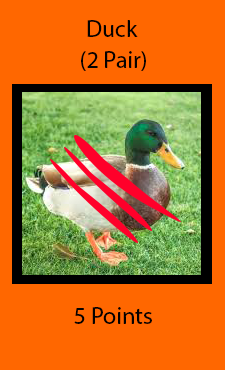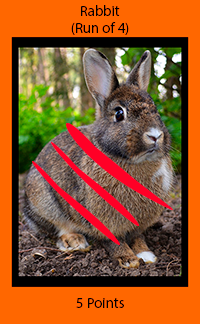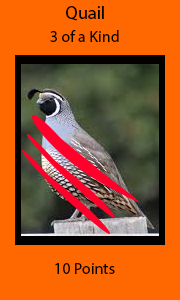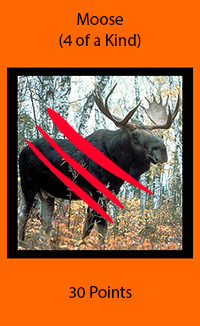




These images are some sample cards.
Growing up I would always play card games with my Grandmother, and one of her favorite games is Phase 10. I have always liked the concept of the game, but the game play is extremely slow, and the games seem to drag on. I decided to take the basic concept of Phase 10 which is a game about making sets and runs in phases and attempted to create a game similar with a faster gameplay speed.
My cousin is an ardent fan of hunting, and when I left for college, he sent me a deck of camouflage cards with whitetail deer on them. When thinking about modifying the game of Phase 10 I came across the idea of a hunting game in which I would modify the camouflage deck to include cards and to match the theme of hunting. I figured I could develop the game so that a set or a run could be played to catch an animal. With the modifications to the deck, I decided to create victory point cards that correlate to each animal that can be caught. I decided to add them to the deck of 52 playing cards to make the scoring of the game easier, and to further develop the theme of the game. I decided to take images of these animals and to alter the background so that it is a hunter orange. To convey that these animals are dead I made red claw marks that cut through the animals. I chose to do this because it is a way to depict death that isn't gruesome, and images of dead animals could be disturbing to some playing the game. This choice euphemizes the game.
The goal of the game is to aquire 100 points through hunting and collecting animals. There are 5 animals that can be hunted for points: Duck, Rabbit, Quail, Elk, and Moose. There is one animal that will penalize you if you hunt it: The neighbor's pet. The cards used to hunt the animals are listed below.
Duck: Two Pair (two sets of two cards with matching numbers)
Rabbit: Run of 4 cards (4 cards in ascending order)
Quail: Three of a Kind (three cards with matching numbers)
Elk: Flush (5 cards of the same suit)
1/2 a Duck and a Quail: Full House (three of a kind and a pair)
Moose: 4 of a Kind (4 cards with matching numbers)
The Neighbor's Pet: One pair (Two cards with mathching numbers) *only happens at the end of each phase
Place the animal cards in piles (place all the duck cards in a pile, all the rabbit cards in a pile, etc.) in the middle of the table so that they are accessible for all players. There is a set of cards that has both a quail and a duck on it and these are their own pile. Deal each player 5 cards from the deck and place the remaining cards in a pile next to the dealer face down. This will be the draw pile for the dealer.
The dealer will start gameplay by picking up the top card from the draw pile so that the dealer has 6 cards in their hand. Then the dealer will discard one card face down to the left. The discard pile to the left of the dealer will become the draw pile for the person to the left of the dealer. This person will discard to their left as well and this process is repeated until the last player discards to their left. At this point the last player's discard pile is not reused by the dealer it is set aside. Gameplay is stopped when there are no more cards in the dealer's draw pile. Gameplay can also be stopped when a player wishes to exchange his cards to catch an animal. In this case the player will yell "cash." This signifies the end of a phase and every player immediately stops drawing cards. Every player then lays down their cards and says the animal that they are able and wish to hunt in that phase. They then grab the card that corresponds to the animal. This is the end of that phase, and the dealer is rotated to the left. (the person to the left of the last dealer becomes the new dealer) The cards are shuffled so that the next phase can begin. This process is repeated until one player has 100 points.
The points are scored at the end of each phase. More difficult animals to hunt score more points.
Below is a list of the scoring for each animal.
Duck: 5 points
Rabbit: 5 points
Quail: 10 points
Elk: 20 points
1/2 a Duck and a Quail (laid down at same time): 25 points
Moose: 35 points
The Neighbor's Pet: -5 points (This is only scored at the end of the phase using the remaining cards in every players hand. If a player has one pair left in his hand at the end of the phase he must take a Neighbor's Pet card.)
Trial 1: In the first trial phase, I found out that the original game that I created was not very balanced. The final player had a massive disadvantage because the players could lay cards down throughout the round and those cards were never given to the final player. What ended up happening was that most of the cards were not even cycled through to the final player. The dealer scored the most points and the points scored decreased with every player to the left of the dealer.
Modifications: After playing the first round I decided to only allow the players to be able to cash in their cards for animals once per round. I placed this limit in order to force the card circulation to reach the final player.
Trial 2: In the second trial phase, the gameplay was more balanced. Every round the point totals were close between all players. This game, however, still was full of flaws. I realized that the lower point cards (the duck, and the rabbit) were not getting played much, and it seemed that it was too easy to get a good hand. If a player had a hand that could be cashed in for a moose (4 of a kind) and score the most possible points this player just had to wait until the end of the round to cash in and the rest of the gameplay for that player in that phase was spent just passing cards from their right to their left.
Modifications: In order to fix these flaws, I changed the rules of the game to make it so that if a player wanted to cash in cards in exchange for animals this player could just yell out cash at any point in the game and everyone playing would have to lay down what they had. This ends the round.
Trial 3: In the third trial phase, the gameplay was a lot faster, and the rounds went very quick. This added a new element of strategy to the game due to this new element of time in the game. ne strategy could be to try to cash in for lower points early in the round if one thinks that other players have worse cards. Another strategy could be to try to wait until your hand is the best that it can be before cashing in. I found that the mix of these two strategies added another flavor to the game that made it more strategic.
Modifications: I made it so that the Moose card was worth 5 more points in order to incentivize players to try to hunt the Moose and to not cash in early with worse cards.
Pictured on the left is the start of one of the games. On the right are some of the sample cards I handmade to test the game.
In the end, I have a newfound respect for the creation of card games. Through this process I learned that the way I imagine a game will play out is vastly different from the way that it plays out. Before the initial playtest I thought that the game I had created would be a national bestseller. However, after playing just three games I’ve been humbled. I was expecting a very fast paced game since the way that the cards flow around the table is similar to spoons, but I came to learn that that might just be one of many possible strategies. As one who complains about the poor balance in games it was very interesting for me to be on the other side of this process and try to fix the balance of the game. I played my game with three people and I am certain that as the amount of people that can play a game increases the number of unexpected outcomes increases as well, which gives me another level of respect for complex multiplayer card games. I found this experience very enjoying and I found it extremely satisfying to create a final product that was not only balanced but that was actually fun to play.
Duck Image:http://pepperpunch.com/male-malard-duck
Rabbit Image:https://en.wikipedia.org/wiki/Rabbit
Quail Image:https://www.inaturalist.org/guide_taxa/845144
Elk Image: https://www.buckhorninn.com/2020/07/elk-in-the-great-smoky-mountains/
Moose Image: https://en.wikipedia.org/wiki/Moose